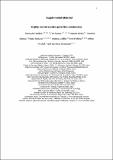Files in this item
Highly excited exciton-polariton condensates
Item metadata
| dc.contributor.author | Horikiri, Tomoyuki | |
| dc.contributor.author | Byrnes, Tim | |
| dc.contributor.author | Kusudo, Kenichiro | |
| dc.contributor.author | Ishida, Natsuko | |
| dc.contributor.author | Matsuo, Yasuhiro | |
| dc.contributor.author | Shikano, Yutaka | |
| dc.contributor.author | Löffler, Andreas | |
| dc.contributor.author | Höfling, Sven | |
| dc.contributor.author | Forchel, Alfred | |
| dc.contributor.author | Yamamoto, Yoshihisa | |
| dc.date.accessioned | 2017-06-22T14:30:10Z | |
| dc.date.available | 2017-06-22T14:30:10Z | |
| dc.date.issued | 2017-06-15 | |
| dc.identifier | 250119175 | |
| dc.identifier | 64fca96b-00b4-4444-ad6a-190304448e6e | |
| dc.identifier | 85023163601 | |
| dc.identifier | 000404019600002 | |
| dc.identifier.citation | Horikiri , T , Byrnes , T , Kusudo , K , Ishida , N , Matsuo , Y , Shikano , Y , Löffler , A , Höfling , S , Forchel , A & Yamamoto , Y 2017 , ' Highly excited exciton-polariton condensates ' , Physical Review. B, Condensed matter and materials physics , vol. 95 , no. 24 , 245122 . https://doi.org/10.1103/PhysRevB.95.245122 | en |
| dc.identifier.issn | 1098-0121 | |
| dc.identifier.uri | https://hdl.handle.net/10023/11065 | |
| dc.description | This research was supported by the Japan Society for the Promotion of Science (JSPS) through its FIRST Program and KAKENHI Grant Numbers 24740277 and 25800181, a Space and Naval Warfare Systems (SPAWAR) Grant Number N66001-09-1-2024, the Ministry of Education, Culture, Sports, Science, and Technology (MEXT), the National Institution of Information and Communication Technology (NICT), the joint study program at Institute for Molecular Science. T. H. acknowledges the support of Toray Science Foundation, KDDI Foundation, the Asahi Glass Foundation, ther Murata Science Foundation, and REFEC. T.B. acknowledges the support of the Shanghai Research Challenge Fund, New York University Global Seed Grants for Collaborative Research, National Natural Science Foundation of China (Grant No. 61571301), the Thousand Talents Program for Distinguished Young Scholars (Grant No. D1210036A), and the NSFC Research Fund for International Young Scientists (Grant No. 11650110425). | en |
| dc.description.abstract | Exciton polaritons are a coherent electron-hole-photon (e-h-p) system where condensation has been observed in semiconductor microcavities. In contrast to equilibrium Bose-Einstein condensation (BECs) for long lifetime systems, polariton condensates have a dynamical nonequilibrium feature owing to the similar physical structure that they have to semiconductor lasers. One of the distinguishing features of a condensate to a laser is the presence of strong coupling between the matter and photon fields. Irrespective of its equilibrium or nonequilibrium nature, exciton polaritons have been observed to maintain strong coupling. We show that by investigating the high-density regime of exciton-polariton condensates, the negative branch is directly observed in photoluminescence. This is evidence that the present e-h-p system is still in the strong-coupling regime, contrary to past results where the system reduced to standard lasing at high density. | |
| dc.format.extent | 562407 | |
| dc.format.extent | 315734 | |
| dc.language.iso | eng | |
| dc.relation.ispartof | Physical Review. B, Condensed matter and materials physics | en |
| dc.subject | QC Physics | en |
| dc.subject | T Technology | en |
| dc.subject | NDAS | en |
| dc.subject.lcc | QC | en |
| dc.subject.lcc | T | en |
| dc.title | Highly excited exciton-polariton condensates | en |
| dc.type | Journal article | en |
| dc.contributor.institution | University of St Andrews. School of Physics and Astronomy | en |
| dc.contributor.institution | University of St Andrews. Condensed Matter Physics | en |
| dc.identifier.doi | https://doi.org/10.1103/PhysRevB.95.245122 | |
| dc.description.status | Peer reviewed | en |
This item appears in the following Collection(s)
Items in the St Andrews Research Repository are protected by copyright, with all rights reserved, unless otherwise indicated.


